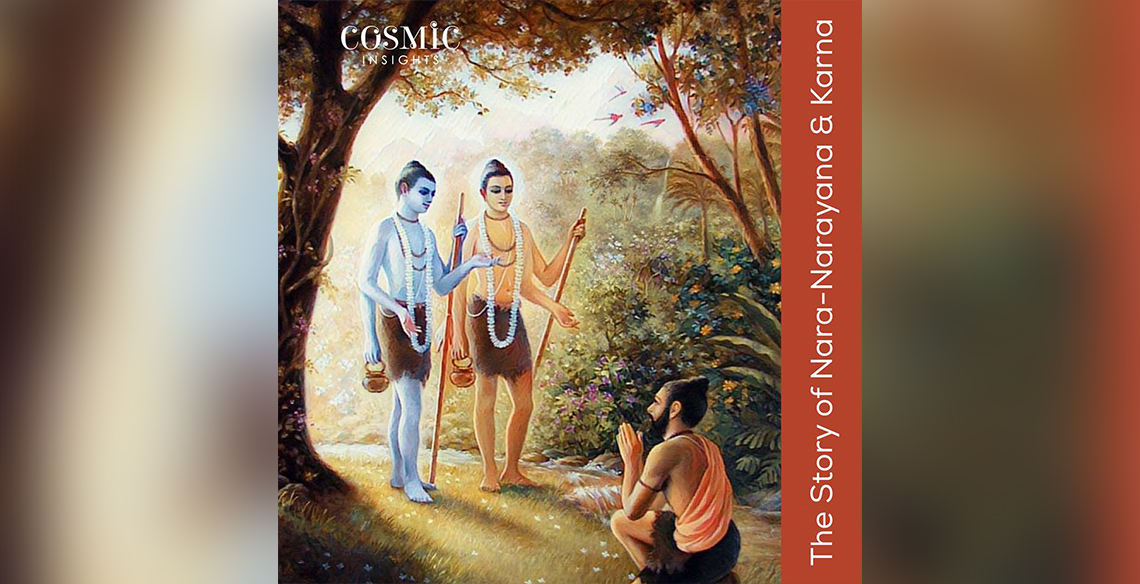Nara-Narayana is the twin-brother avatar of the God Vishnu on earth, working for the preservation of dharma or righteousness. In the concept of Nara-Narayana, the human soul Nara is the eternal companion of the Divine Narayana. In the Mahabharata, Krishna, addressing Arjuna, says, “Thou wast Nara in a former body, and, with Narayana for thy companion, didst perform dreadful austerity at Badari for many myriads of years.”
The twins were sons of Dharma, the son of Brahma and his wife Murti (Daughter Of Daksha) or Ahimsa. They live at Badrika performing severe austerities and meditation for the welfare of the world. These two inseparable sages took avatars on earth for the welfare of mankind.
The mountains around Badrinath are mentioned in the Mahabharata, when the Pandavas were said to have expired one by one, when ascending the slopes of a peak in western Garhwal called Swargarohini.(literal meaning – the ‘Ascent to Heaven’). The Pandavas passed through Badrinath and the town of Mana, 4 km north of Badrinath, on their way to Svarga(heaven). There is also a cave in Mana where Vyasa, according to legend, wrote the Mahabharata.
The area around Badrinath was celebrated in Padma Purana as abounding in spiritual treasures.
The Story of Nara-Narayana and Karna
An interesting story is told that once an asura, who had pleased Brahma with his devotion, was granted a boon by the Creator of this universe, “Your life exists in the thousand kavachas (armours) that I have bestowed upon you and because of which none can kill you. But, if any one of your enemies were to remove the kavachas from your body, then you would lose all your powers. I also grant you another boon-one who takes away even one kavacha from you will have to fight you for a hundred years.”
With such powerful boons granted to an asura, it was enough reason for this to go to his head. He began to exercise his powers for both good and evil purposes, as a result of which all came to dread him and gave him the name Sahasrakavacha (a hundred armours). The devas were so disgusted with his behaviour that they decided to approach Lord Vishnu to seek his intervention. On hearing their pleas, Lord Vishnu agreed to help them and descended on earth in the form of two men, named Nara and Narayana.
Now these two men challenged Sahasrakavacha to a battle, which the asura willingly accepted, conscious as he was of his prowess and the hundred kavachas that he wore.
The day of the battle arrived. Nara engaged Sahasrakavacha in the confrontation for a hundred years while Narayana sat down to do penance. After a hundred years, Nara managed to force one kavacha off from the asura’s body by piercing through it and then embarked on penance. Meanwhile, Narayana took up the battle from where Nara had left. Thus alternating with each other, Nara and Narayana continued fighting with the asura, till he was left with only one kavacha upon his body.
Now Sahas-rakavacha realised that he was left with the last kavacha and if that too was ripped off his body, he would die. So, he went and hid himself behind the Sun-god. With Sahasrakavacha having left the field, Nara and Narayana returned to heaven.
After a long time, a son was born to Kunti with the blessings of the Sun-god. The child was named Karna and he was born wearing a single kavacha upon himself. This evidently proved to the shocked people around him that Karna was none other than Sahasrakavacha who had taken rebirth as Karna.
As we all know, in the battle of Mahabharata, Karna supported Duryo-dhana. Lord Indra disguised himself as a poor Brahmin and approached Karna for alms. Karna was a kind-hearted man, so he willingly took out his kavacha to hand over to the poor Brahmin. With the last kavacha off, Karna went to the battlefield and was killed by an arrow directed at him by Arjuna, who rode his chariot with Lord Krishna driving it. Arjuna and Krishna were Narayana and Nara respectively, in earlier life and were responsible for killing Karna.
Thus, as promised by Brahma, Sahasrakavacha lived so long as he wore the kavachas.

